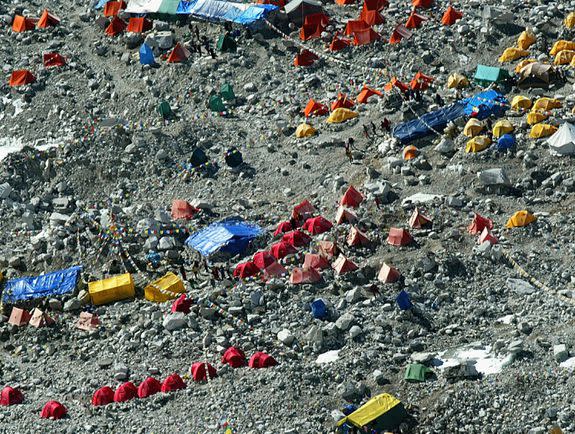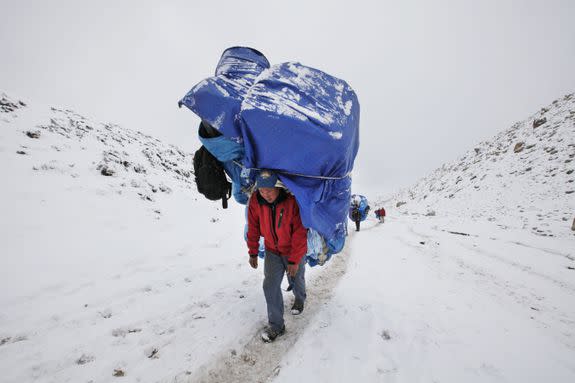Sherpas show how the human body can thrive in extreme environments

Mount Everest is a grueling, deadly place for many adventurers. Beyond the steep terrain, bone-chilling temperatures, and fierce weather, the air is so thin that your body can begin to shut down.
That is, unless you're a Sherpa.
Members of the Nepalese ethnic group have evolved over generations to withstand the oxygen-deprived atmosphere high in the Himalayas, a new study found.
SEE ALSO: Now you can climb Mount Everest in VR
Sherpas are, biologically speaking, extremely efficient at producing the energy they need to reach such heights, even where oxygen is scarce, according to research published Monday in the Proceedings of the National Academy of Sciences.
Their cells are akin to fuel-efficient cars that can travel farther on less fuel.

Image: Tashi Sherpa/AP/REX/Shutterstock
Scientists say the findings not only help explain Sherpas' mountain-climbing prowess — they may also lead to new ways of treating oxygen deficiencies, called "hypoxia," in hospital patients.
"By understanding how Sherpas are able to survive with low levels of oxygen, we can get clues to help us identify those at greatest risk in [intensive care units] and inform the development of better treatments to help in their recovery," Michael Grocott, a co-author of the study and professor at the University of Southampton in England, said in a press release.
Grocott is the chair of Xtreme Everest, a 10-year-old initiative by doctors, nurses, and scientists to study how our bodies respond to the extreme altitude on Mount Everest. Their ultimate goal is to improve outcomes for critically ill patients.
With a 29,029-foot-high peak, Everest is the world's highest mountain. Everest Base Camp is around 17,600 feet, which is plenty high enough to sicken unadjusted visitors.

Image: Paula Bronstein/Getty Images
At those altitudes, where oxygen is scarce, the body is forced to work overtime to make sure the brain and body receive enough oxygen to function. Often, the body will produce more red blood cells, which carry blood to our organs and thicken the blood. As a result, blood flows more slowly and blood vessels are prone to tightening, which can cause dangerous build-up of fluid in the lungs and other risks.
Mountain climbers can combat this by bringing oxygen supplies and ascending slowly, giving their bodies time to adjust. Sherpas, however, don't need such a boost.
Previous studies have shown that Sherpas produce fewer red blood cells at higher altitudes. They also produce higher levels of nitric oxide, a chemical that opens blood vessels and keeps blood flowing, which in turn gives them more energy to climb.
Sherpas' remarkable physical skills, along with their local expertise, have made them the go-to guides and porters for international expeditions. It's an imperfect arrangement, however. Nepalese guides in recent years have protested poor pay and unsafe working conditions, and in 2014, they went on strike after 16 colleagues were killed in an avalanche.

Image: eric thayer/Getty Images
For Monday's study, a research team led by scientists at the University of Cambridge followed 15 Sherpas and 10 "lowlanders" — researchers living in non-high altitude areas — as they gradually ascended to the base camp.
The lowlanders took samples, including blood and muscle biopsies, at three different times: in London, for the baseline measurement; upon arrival to base camp; and after two months working at base camp.
They compared those samples to those of the Sherpas, all of whom lived in relatively low-lying areas, and none of whom were "elite" high-altitude climbers. Sherpas' baseline measurements were taken in Kathmandu, Nepal.
At baseline, Sherpas' mitochondria — the parts of human cells that respire to generate energy — were already more efficient at using oxygen to produce ATP than those of lowlanders, the samples revealed. ATP, or molecule adenosine triphosphate, is the energy that powers our bodies.

Image: Tashi Sherpa/AP/REX/Shutterstock
Sherpas' measurements hardly changed once they reached the base camp, suggesting they were born with such biological traits. Lowlanders, meanwhile, saw their measurements change as their bodies acclimatized and began to mimic the Sherpas'.
After two months at camp, Sherpas also produced more phosphocreatine, an energy reserve that acts as a buffer to help muscles contract when no ATP is available. Lowlanders, by contrast, saw their phosphocreatine levels crash.
And, unlike lowlanders, Sherpas did not experience a rapid increase in free radicals, which are molecules created by a lack of oxygen that can potentially damage cells and tissues.
"Sherpas have spent thousands of years living at high altitudes, so it should be unsurprising that they have adapted to become more efficient at using oxygen and generating energy," Andrew Murray, the study's senior author and a senior lecturer at the University of Cambridge, said in the press release.
"When those of us from lower-lying countries spend time at high altitude, our bodies adapt to some extent to become more 'Sherpa-like', but we are no match for their efficiency," he said.
WATCH: Drone captures breathtaking footage of Norwegian mountains

